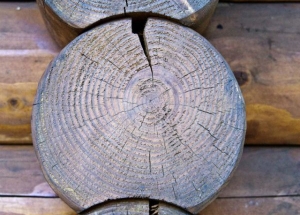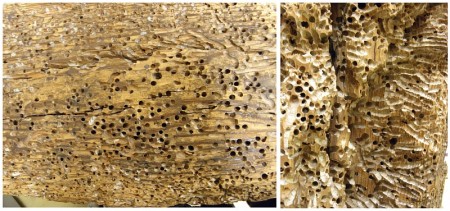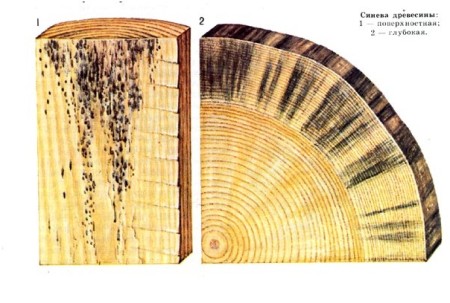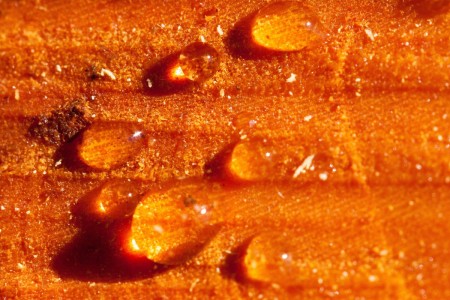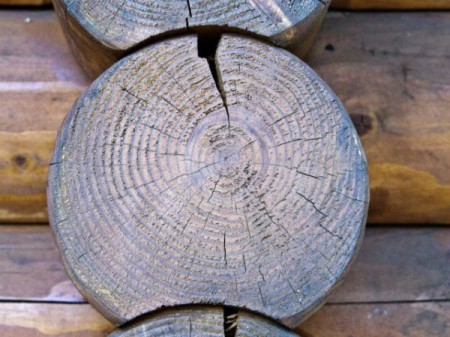Wood is an excellent building material: it is environmentally friendly, well retains heat, is well processed and looks beautiful. However, she is afraid of everything: fire, water, ultraviolet radiation, fungus, insects. Houses made of wood are quite expensive and that they can serve people for many years, wood must be reliably protected from all these factors, for which you need to know how to prepare for painting and how to paint a wooden house from the outside.
Content
Factors causing destruction of wood
Over time, the wood is destroyed and the rate of its destruction depends on the degree of protection.
Under the influence of atmospheric precipitation and changes in air humidity, the wood then swells from the absorbed moisture, then shrinks after drying, resulting in its cracking.
When the water that has got into the cracks freezes, the ice expands and the fibers subsequently break.
Ultraviolet rays significantly affect the wood and destroy lignin, which is its basis and is responsible for the density, hardness and color of the wood. Under the influence of sunlight, the structure of the lumber becomes loose and rough.
Timber is often affected by a fungus that stains wood and eventually destroys it. A favorable environment for active propagation of fungus spores is high humidity and high temperature.
Often, wood is affected by insects, which in it found themselves and the house, and food. These include all kinds of woodworm bugs, weevils, borers, grinders and many others. Some live in freshly chopped trunks, others - in the wood of already constructed buildings, but all of them actively destroy the wood and make it unfit for use in construction.
All these factors, as a result of their destructive effects, lead to a significant reduction in the life of the wood.
The order of wood processing
To understand how to protect lumber from aging, you need to know the structure of the wood. Deciduous and coniferous trees have a different texture. It can be simplified to imagine that along the entire length of the trunk there are numerous elongated cells responsible for transferring the feeding fluid from the roots to the branches. That is why, through the end face, the moisture is most intensively absorbed into the wood with increased humidity of the environment and evaporates at a low level.
To maximize the life of wooden buildings, it is necessary to protect the wood from the destructive effects of the environment, for which the three-level protection system is most often used.
- Protection of the ends of the wood from moisture absorption by means of the ends. It can be performed as all kinds of liquid impregnations, and thick mastics. Means for the ends can reliably "seal" the so-called pores and prevent saturation of the wood with moisture.
- Protection of the surface from the effects of fungus and insect damage using antiseptic agents. Antiseptic has a liquid consistency, due to which penetrate deep into the wood and can protect it from decay and insects.
- Protect the surface from UV rays and atmospheric precipitation with paint.
Preparing for painting the house
fungus removal
If a fungus is found on the wood, you should get rid of it before you start painting. Combating the fungus should begin with the elimination of the causes of its occurrence: high humidity and temperature. Spores of the fungus are very volatile and also often cause allergies in humans. The place damaged by the fungus is mechanically removed by any of the available means: a knife, a scraper, a cicle, a metal brush, etc. The resulting shavings, sawdust, wood dust should be carefully collected and burned to prevent further spread of the fungus. The cleaned area is thoroughly washed with a cleaning solution and dried.
For the destruction of the fungus, the wood is treated with special antiseptic means, a large number of which is available in the trade network. Popular methods for combating mold are the treatment with hydrogen peroxide, chlorine bleach "Belizna", vinegar, aqueous ammonia solution, aqueous borax solution and some others. Antifungal preparations should also be treated for areas of wood adjacent to the affected, as they are also likely to be infected with spores of the fungus.
resin removal
The resin protects the wood from decay and insects, but when painted, a large amount of resin will interfere with the adhesion of the paint to the surface. Remove resin from the wood in places where there are knots, you can mechanically by using a knife, spatula or the like tool. If it still continues to perform, then this place needs to be heated with a construction hair dryer and first removed mechanically, and then removed with nitro-solvent, alcohol, whitespirit, purified gasoline, turpentine or an ammonia-based solvent. After removing the resin, this place is carefully ground. However, one must know that it is impossible to completely get rid of the resin.
surface grinding
Before applying the paint, it is necessary to prepare the wooden surfaces for painting. This is done first rough, and then finish grinding.
Not all owners of wooden houses take up the facade polishing, because they consider this a very long and laborious work. However, the polished façade looks more beautiful and effective, and the applied paint penetrates the wood structure better, while its consumption decreases, approaching the data declared by the manufacturer.
For rough grinding, abrasive materials with a grain size of 60-80 are used, and for final grinding - with a grain size of 120. Smaller abrasive materials are undesirable, because in this case the pores of timber are clogged and the applied protective coatings can not penetrate deeply into the wood. When transitioning from coarse-grained sandpaper to fine-grained, one should not make sharp jumps, but use nazhdachku with a medium-sized grain.
Manual cleaning of such a large area as the walls of the house is very difficult, therefore it is recommended to use power tools and consumables for them. The surface can be processed using grinding machines of various types: angular, eccentric, belt, vibrating. For grinding wood in hard-to-reach places, it is necessary to use angled attachments on the vibrating grinder.
If the surface of the wood has previously been treated with varnish or glue, then the old paintwork must be removed. This can be done mechanically, and to accelerate the process it is recommended to soften the old coating with a construction hair dryer and remove with a spatula. Professionals are also advised to use specialized means to soften the varnishes and paints, which are available in sufficient quantities in the sales network. After loosening, the old coating is removed mechanically.
The wood that is to be painted must be dry and clean, so the surface must be cleaned from dust with a vacuum cleaner or brush before grinding.
Grinded wood must be treated within a day, otherwise the depth of penetration of soil, paint or varnish into the structure of the tree will decrease.
We paint a wooden house with our own hands, useful advice
end processing
The ends of the lumber require careful processing and additional protection, as they are a place of intensive absorption of moisture.
Before applying the protective material, it is necessary to level and polish the end face. To handle the ends are used as folk methods, and a sufficient number of factory tools. The first can be attributed to the surface of machine oil, drying oil, oil paint, a mixture of PVA glue and acrylic lacquer. Each of these recipes has its drawbacks, so professionals recommend that you still use specialized materials for finishing the ends. They are characterized by ease of use and ease of application, high efficiency, quick drying, compatibility with most paints. However, it is worthwhile to try to ensure that the means for the ends do not fall on other surfaces, since the subsequent paintwork may not stick to it.
If you can not rush to handle the trunk itself, then the butt is the weakest place of wood, so after the construction of the house it should be protected first, better - immediately after laying the logs. The surface intensively absorbs the liquid, so the agent must be applied in several layers. For processing it is more convenient to use the usual brush.
priming on wood
After grinding, the treatment of the wooden surface before painting is carried out using an antiseptic primer. The use of a primer increases the strength of wood, protects the material from moisture and damage to insects, increases the adhesion of the paint. The soil-antiseptic for wood many times reduces the risk of its infection with fungus, and fire retardant additives, which can be part of the primer, prevent the burning of wood. The paint coating, which is applied over the ground, will not flake and crack over time, and its consumption will be significantly reduced. Due to the primer, subsequent layers of paint fall more evenly, which affects the appearance of the painted wood.
Depending on the materials that make up the primer, they can be alkyd, acrylic, epoxy, polyurethane, shellac.
- alkyd primers are very suitable for primary impregnation of wood, they are best protected and wood is prepared for painting. The primer includes alkyd resin, light-protective pigments and antiseptic additives. Primers have a specific sharp odor and dry for about 12 hours;
- acrylic primers due to their safety and environmental friendliness are more often used for indoor wood processing. The composition of primers includes acrylic paint and latex mixture. They are well and deeply absorbed, increase the adhesion of paints and quickly dry;
- epoxy and polyurethane primers are diluted paints with special solvents. They have high resistance to external influences, but are unsafe to use, have a high price and are rarely used. The time of their drying is about a day;
- shellac primers are mainly designed to fight the resin and they handle knots.
The surface to be treated must be dry and clean, free of dirt, paint, dust and sawdust. Apply primer in any convenient way: brush, roller or spray. It is only necessary to monitor the uniformity of the application and adhere to the consumption rates indicated on the packaging.
choice of the type of paint
The owner of private housing before painting a wooden house, the question arises: what paint paint a wooden house? The paint, which is used for the facade of the house, has the most stringent requirements: it must be moisture resistant, withstand high humidity, high and low temperatures, bright sun rays. It is desirable that the paint for outdoor works have a high elasticity. Such paints are less susceptible to cracking in the event of temperature differences.
Paints for wooden facades can be divided into the following main groups:
- acrylic paint. The composition of the paint includes esters of acrylic acid and water. In European countries, acrylic paint has almost replaced other types of paints due to high safety and resistant frost-resistant coating. The paint is easily mixed, resulting in any desired color shade, which remains intact for a long time. Unlike oil and alkyd, it does not support combustion due to the substances in the paint. To the group of acrylic paints also it is possible to carry water-dispersed paint. Acrylic paint can be applied in a variety of ways: with a brush, roller or spray. The coating service life is from 5 to 10 years. Acrylic paint is universal and suitable for various materials: wood, metal, concrete, etc. To get the best result, you should choose the paint, designed specifically for wooden structures. There are some limitations in the storage of acrylic paint: it can not be kept at negative temperatures, since when it freezes, it loses its properties;
- alkyd paint. The composition includes alkyd varnish (pentaphthalic and glyftalic), solvents, coloring pigments and various fillers. Alkyd paint can be given antiseptic properties, for which the composition of the paint is injected with antiseptics. In our country, paint is in demand due to a relatively low price and good resistance to external influences. The paint is elastic, well withstand direct sunlight and resistant to aggressive detergents. Due to the thin film that appears on the surface after drying, the paint protects well from moisture, however, under the influence of ultraviolet rays, the film quickly becomes thinner and cracked. In comparison with acrylic paint, the alkyd coating is less durable, its service life is about half that;
- oil paint. The oil paint is based on linseed oil, dyeing pigments and fillers, depending on the presence of which the paint is given certain properties: fire resistance, acid resistance, water resistance, etc. Oil paint protects wood from sunlight, moisture, it is resistant to changes in temperature and humidity, to contamination. At the same time, the paint is toxic, has a sharp unpleasant odor and dries long. To obtain a good result, the painting should be performed only in dry and cool weather. In the west, oil paint is practically not used. The service life of the paint coating is about three years, and when painting over the oil paint, only paint of the same type can be used.
paint application
Antiseptic agents are not able to protect the tree from sunlight, and over time, under the influence of atmospheric precipitation, they are removed from the wood, so a fixing layer of varnish, oil or paint is applied over the antiseptic layer. Application of color coating is possible only after the complete drying of the soil. It is not recommended to use a colorless coating, as it does not provide protection from ultraviolet radiation and is much less than that in which color is included.
Hats of nails and screws, other steel products even under the coloring layer are susceptible to oxidation, which can lead to darkening of the paint around the metal parts. To prevent this, it is necessary to cut them into wood for a few millimeters and treat them with an anticorrosive primer.
To accelerate the painting of large areas, such as the walls of a building, it is best to use a roller or spray. In addition, they will allow to apply a primer or paint on the surface more evenly. Painting a large area is quite a laborious occupation, so do not undertake this work alone.
The color of the paint can be anything, it all depends on the taste and preferences of the owner of the house. Before painting, you need to carefully calculate the right amount of materials, since if you have to buy the missing amount of paint, it may turn out that the color in the other batch may be slightly different.
Painting the facade is better in dry weather, while avoiding direct sunlight. Begin painting better from the roof, gradually sinking down. To reach the top of the facade, you can use an extension cord for the brush or roller.
When applying several layers of primer or paint, do not rush to apply the next layer, but it is worth waiting for the complete drying of the previous one.
The paint should be plentiful, but at the same time smoothly and without streaks. To facilitate painting in hard-to-reach places, it is convenient to use a brush with a curved handle.
If you follow the processing and painting technology, your wooden house will be pleasing to the eye for many years, reliably protecting it from rain, snow, heat and cold.


